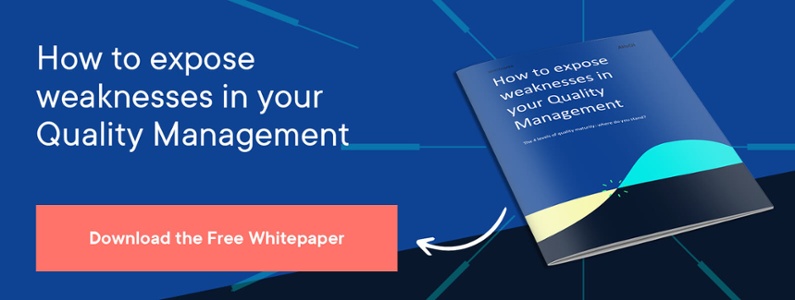Manufacturers do not rely on their instinct to carry out Quality Control, so any attempt to assess how well we manage the process should be as objective and data-driven as possible. This is obvious, but difficult to achieve in practice. A recent piece of research by Forrester reveals a startling lack of ‘data activation’ as it turns out that senior management, rather than rely on the data analysis in which it has invested heavily, often bases business decisions on opinion and ‘gut feeling’.
Big Data may be among us, but old habits die hard.
In our blog, Quality Intelligence: why automation makes you smarter, we invited quality management leaders to take a selfie of how they were doing – or thought they were doing – as a starting point towards recalibrating and improving their processes. Naturally, you cannot let your findings be influenced by your impression of how well you are doing.
What you spend on Quality Control is a misleading metric, because a sure sign of poor quality management is a lack of insight into costs.
This problem of objectivity is not new. The father of modern quality management, Philip Crosby, devised a maturity grid which is the forebear of the matrix in this blog. Crosby published his tool, and the classic text Quality is Free, at the tail-end of the hippie era in 1979. His five stages of quality maturity certainly reflect that. They are: Uncertainty, Awakening, Enlightenment, Wisdom, and Certainty.
Only a quality management guru would prize certainty over wisdom!
Quality Intelligence Maturity Model
Take a quality-selfie using our maturity model.
Of course, what you call the stages is not in itself important; they are landmarks on a journey of change with no sharp or logical cut-off points between the different levels of maturity. Our own grid distinguishes four stages of Quality Intelligence maturity, and Crosby would certainly have recognized our Level 1, Ad hoc & Isolated, where – in his words – problems are handled ‘with lots of yelling and accusations’ which we describe as ‘incident-driven communication’.
But our other levels would not have been so familiar. In 1979, the Information Revolution was in its infancy and Crosby could not have imagined back then what we mean by Smart & Integrated, the level where modern quality management is creating the maturity that is achievable with today’s technology.
Our measurement categories also reveal where Crosby’s matrix is outdated. We include Data management and Analytics & Reporting to the list of yardsticks against which we ask manufacturers to score themselves. They had data in the 1970s, and analyzed them (certainly at Pershing missiles, where Crosby ran the Quality Control program), but with a fraction of the power that we have now. We also list Supply chain integration as one of our categories, because it is technically feasible today to link your real-time data with those of your suppliers, leading to a significant reduction of refused deliveries.
We do not pretend our matrix is the only way to assess your Quality Intelligence maturity, but it is one that reflects our experience of the issues faced by today’s quality teams, in start-ups as well as Fortune 500 manufacturers.

Automation and integration are key drivers of Quality Intelligence, and in our model, the four levels of maturity are based on how effectively your quality management processes are automated and integrated. Some of the key attributes that determine where you are in that journey towards Quality Intelligence are somewhat technical in nature, but we have tried to keep the categories as broad as possible because inclusiveness is one of the hallmarks of Quality Intelligence.
In Parts Two and Three of this blog, we shall take a detailed look at some of the aspects of our Maturity Matrix, but we want to conclude with this crucial point. Not everyone in your manufacturing company has the same experience of Quality Control. Members of the quality management team are likely to have similar views on how this process is managed. But what about the marketing department? Senior management? R&D? Your shop floor engineers? What do they make of it? This divergence of experience and judgment is in itself a very important indication of how quality management could be improved. So make sure that everyone gets a copy of the self-assessment grid, which can be completed in a matter of minutes.
Of course, it is not the kind of statistically controlled exercise that is the basis of Quality Control, but nevertheless, the larger your sample, the more you find out about the effectiveness (or otherwise) of your quality management.
To take the survey, and find out more about your Quality Intelligence Maturity, download our white paper, How Mature is your Quality Management?



